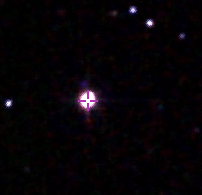PDS 110
 PDS 110 Credit: Two Micron All Sky Survey (2MASS) | |
| Observation data Epoch J2000.0 Equinox J2000.0 | |
|---|---|
| Constellation | Orion |
| Right ascension | 05h 23m 31.008s |
| Declination | –01° 04′ 23.68″ |
| Apparent magnitude (V) | 10.4 |
| Characteristics | |
| Spectral type | keF6IVeb[1][2] |
| Astrometry | |
| Proper motion (μ) | RA: 1.146 ± 1.067[2] mas/yr Dec.: −0.338 ± 1.076[2] mas/yr |
| Parallax (π) | 2.91 ± 0.34[2] mas |
| Distance | approx. 1,100 ly (approx. 340 pc) |
| Absolute magnitude (MV) | +2.54[2] |
| Details | |
| Mass | 3.0[3] M☉ |
| Radius | 2.23[2] R☉ |
| Luminosity (bolometric) | 7.76[2] L☉ |
| Surface gravity (log g) | 3.8[2] cgs |
| Temperature | 6,653[3] K |
| Metallicity [Fe/H] | +0.06[2] dex |
| Age | 10[3] Myr |
| Other designations | |
| Database references | |
| SIMBAD | data |
PDS 110 is a young 11th magnitude star located approximately 1,100 light years away in the constellation Orion. In 2017, it was discovered that the star is orbited by an exoplanet or brown dwarf with a disk of dust around it.
Description
PDS 110 is a young star still approaching the main sequence. It has been classified as a T Tauri star,[4] or as a pre-main sequence star.[3] The emission lines indicative of a T Tauri classification are somewhat weaker than a typical T Tauri star, interpreted as a post-T Tauri stage.[3]
Dust disk around secondary object
Brightness measurements from SuperWASP and KELT showed two similar reductions in brightness in November 2008 and January 2011, both with a maximal luminosity reduction of 30% and a duration of 25 days. These events are interpreted as transits of a structure with a period of 808 ± 2 days, corresponding to an orbital distance of about 2 AU. The large reduction in brightness happens due to a planet or brown dwarf with a circum-secondary disk of dust with a radius of 0.3 AU. The object in the center of the disk has a mass between 1.8 and 70 times the mass of Jupiter. The next transit is predicted for September 2017.[2]
See also
- EPIC 204278916 - star showing unusual light fluctuations
- KIC 8462852 - star showing unusual light fluctuations
- 1SWASP J140747.93-394542.6
- WD 1145+017 - star destroying planetesimal, producing a dusty disk
References
- ↑ Miroshnichenko, A. S.; Gray, R. O.; Vieira, S. L. A.; Kuratov, K. S.; Bergner, Yu. K. (1999). "Observations of recently recognized candidate Herbig Ae/Be stars". Astronomy and Astrophysics. 347: 137. Bibcode:1999A&A...347..137M.
- 1 2 3 4 5 6 7 8 9 10 Osborn, H. P.; et al. (2017). "Periodic Eclipses of the Young Star PDS 110 Discovered with WASP and KELT Photometry". arXiv:1705.10346
 [astro-ph.EP].
[astro-ph.EP]. - 1 2 3 4 5 Rojas, G.; Gregorio-Hetem, J.; Hetem, A. (2008). "Towards the main sequence: Detailed analysis of weak line and post-T Tauri stars". Monthly Notices of the Royal Astronomical Society. 387 (3): 1335. Bibcode:2008MNRAS.387.1335R. doi:10.1111/j.1365-2966.2008.13355.x.
- ↑ Gregorio-Hetem, J.; Hetem, A. (2002). "Classification of a selected sample of weak T Tauri stars". Monthly Notices of the Royal Astronomical Society. 336: 197. Bibcode:2002MNRAS.336..197G. doi:10.1046/j.1365-8711.2002.05716.x.